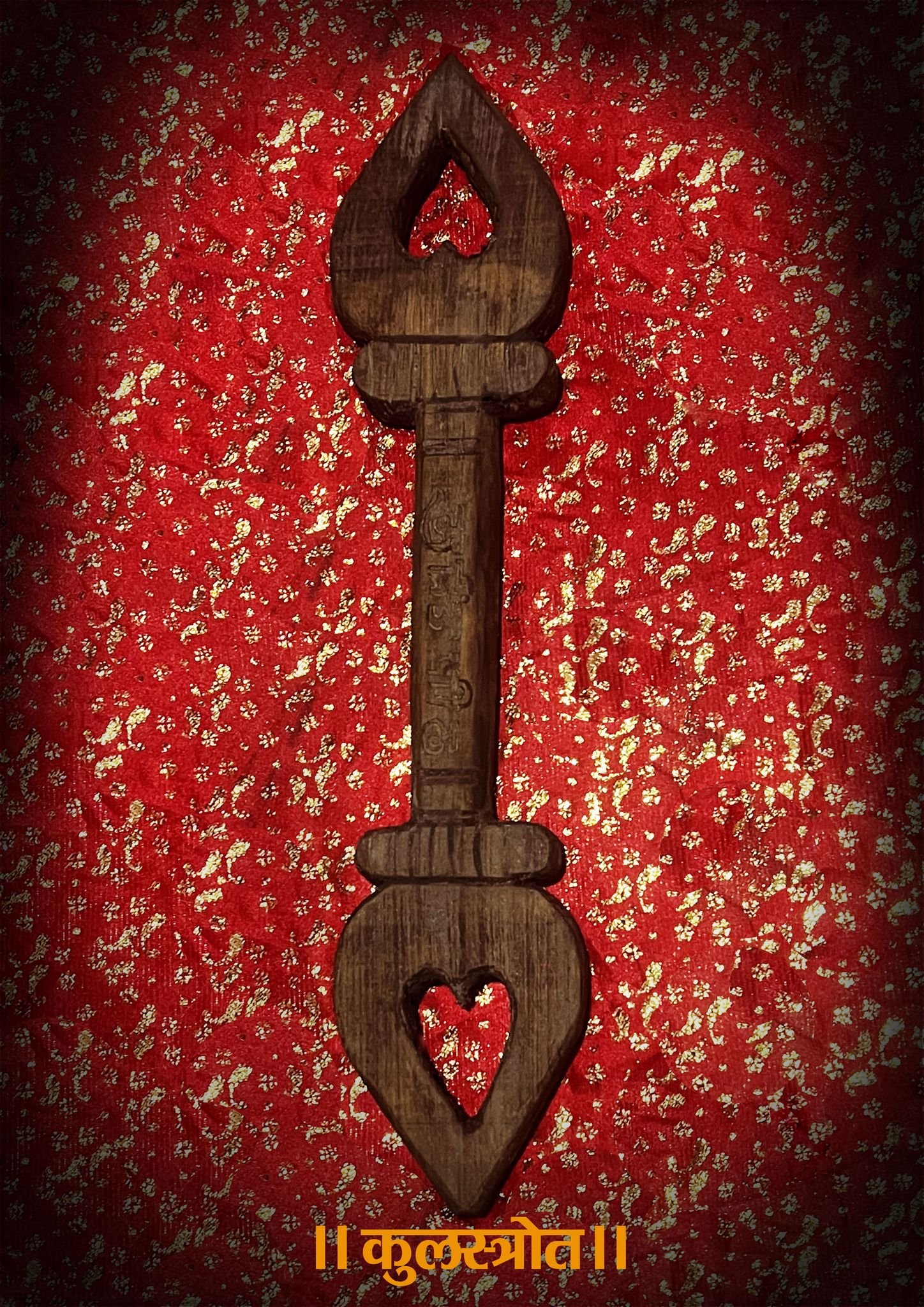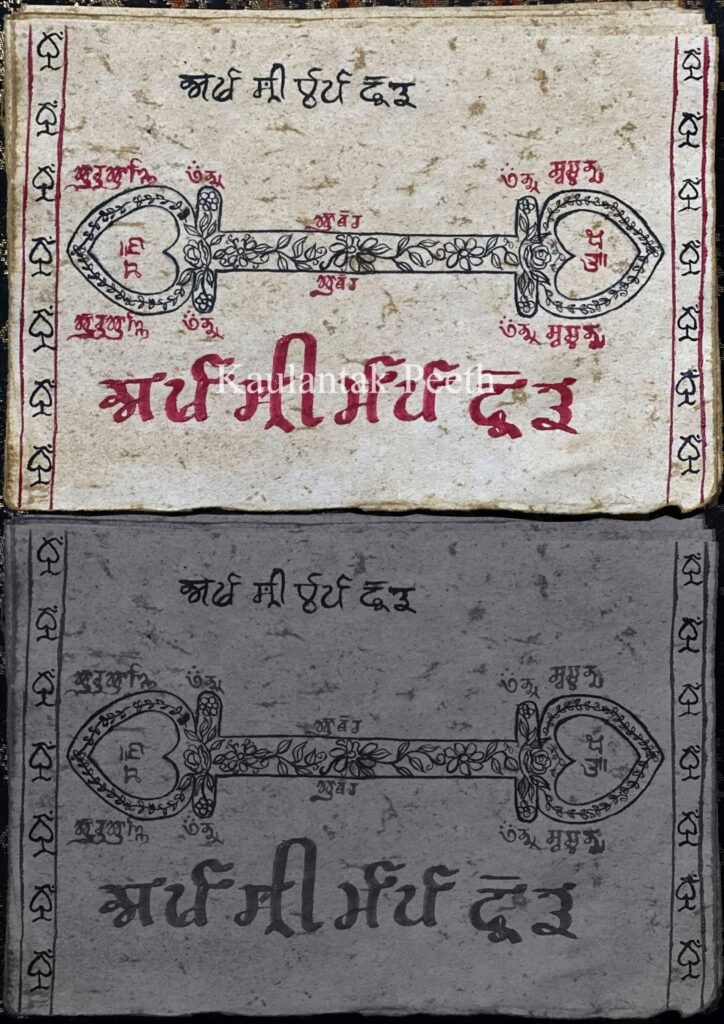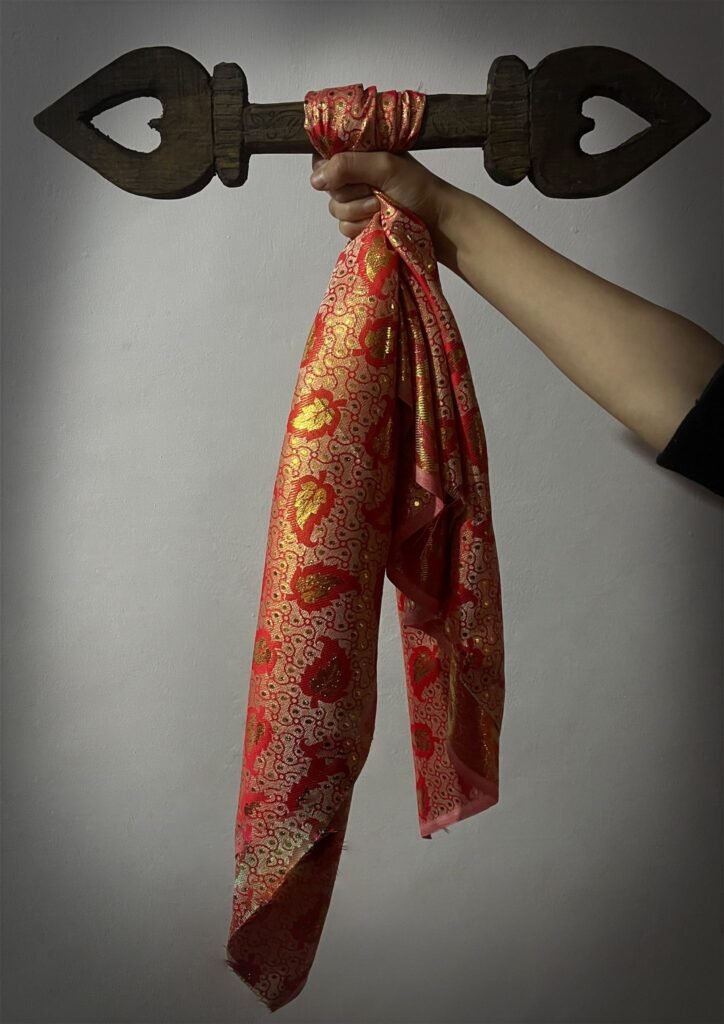The Kulasrota, deriving its name from “kula” meaning tradition, is a tantric yogic tradition where “srota” signifies origin or source. It represents a place from which diverse traditions originate. Deeply rooted in the Himalayan Siddha tradition, Kulasrota is a yantra or ritual implement associated with Goddess Kurukulla.
The design of Kulasrota features the “Kam beej” symbol of Goddess Kurukulla at both ends of a long handle, which is also symbolic of the Kulant Peeth. The Kam beej resembles a broad betel nut leaf, but in Kulasrota, it should be hollow or have a gap in the middle. This hollow design allows air to pass through when specific mantras are chanted during rituals, thus charging the yantra. Kulasrota can be crafted from various materials including ashtadhatu, a combination of eight special metals, or lighter materials like wood from sacred trees such as deodar, horse chestnut, soapnut, and mulberry. It is also made from crystal, and the handle is often wrapped in a royal sacred cloth.
This ritual implement, revered and kept at the altar or in sacred places, is not a weapon but a spiritual tool used in various rituals. There is a specific technique to hold it, with one end called dakshinaang representing the power of Shiva, and the other, vaamaang, representing Shakti. The Kulasrota symbolizes wisdom and serves as a tool for environmental purification and the refinement of virtues.
The Kulasrota has profound uses, extensively employed by Siddhas of the Himalayas. When a yogi is in a new or unfamiliar place, they may use the Kulasrota to create a protective shield around themselves by moving it around their body and chanting specific mantras, ensuring uninterrupted practices. It is also used to purify the environment, cleanse negative energies from places and people, and even for exorcism. Yogis often meditate while holding the Kulasrota, bringing it to the agya chakra to harness specific energies.
Different traditions of Kurukulla use the Kulasrota. Himalayan shamans utilize it to enter states of trance and connect with spiritual realms. Bhairavs and Bhairavis of Kulant Peeth use it in their practices as a potent symbol of transformation and to obtain blessings from Siddha gurus, realizing the interconnectedness of material and spiritual realms. The Kulasrota is a profound tool for practitioners aiming to achieve dev samadhi and bhaav samadhi.
Etymology
The term “Kulasrota” combines spiritual and material concepts. The right side, or “dakshinbhaag,” represents the spiritual realm, imbuing spiritual power and wisdom. Conversely, the left side, known as “vaambhaag,” symbolizes material powers and prowess. The goddess Kurukulla, associated with both enjoyment (“bhog”) and liberation (“moksha”), bestows these dual aspects. Kulasrota embodies the balance and harmony between indulgence in worldly pleasures and the pursuit of spiritual liberation. It is a prominent symbol of Goddess Kurukulla. Kaulantak Nath, the head of Kulant Peeth, often holds the Kulasrota during Siddha rituals. Additionally, the revered Maha Siddha Garuda Suta Nath was gifted the Kulasrota by Goddess Kurukulla, further highlighting its deep spiritual significance.
Origin
According to Siddha Dharma, Maha Siddha Garuda Suta Nath, while conducting his sadhana in a cave-like dwelling in the Himalayas with his disciples, faced numerous supernatural disturbances. Local deities would mysteriously cause water stored nearby to disappear, and roaming spirits frequently created obstacles for his practices. It is recounted that certain Yakshas and Gandharvas would seal the cave entrance with large stones, and various astral beings manifested to intimidate him. In search of a solution, he journeyed to Mount Kailash. There, Bhagwati Kurukulla bestowed upon him the Kulasrota, a powerful tool imbued with the wisdom of all traditions and the ability to counteract and control any tantric practices performed by others. Devi Kurukulla instructed Maha Siddha Garuda Suta Nath to regard the Kulasrota as an embodiment of herself and to venerate it as such. This divine gift was meant to aid him in overcoming the spiritual challenges he faced.
Fabrication and Components
Kulasrota is crafted on auspicious occasions such as Guru Pushya Nakshatra, Holi, and Diwali. On these significant days, artisans cut wood specifically for making Kulasrota. The crafting process varies based on the purpose and the maker’s tradition, reflecting the diversity of its use among different Siddha practitioners. There are three primary components of a Kulasrota: the ‘beej’ (seed), ‘bandha’ (joint), and ‘hasta’ (handle). The ‘kam beej’, the handle, and the connecting ‘bandha’ are individually crafted and later assembled.
Depending on its intended use and qualities, a Kulasrota can be ‘sattvik’, ‘rajasik’, or ‘tamasic’. A sattvik Kulasrota, typically made entirely of wood, is carved from a single piece without any separate parts. A rajasik Kulasrota might incorporate wood, metals, crystals, gems, and occasionally bird feathers. Conversely, a tamasic Kulasrota is made from materials like bones and leather and may include various metals or alloys, often adorned with skull carvings to emphasize its purpose.
The Kulasrota has two distinct sides: the ‘maayaa bhaag’ (illusion side) and the ‘chaayaa bhaag’ (shadow side). The front, or maayaa bhaag, identified by flower engravings, is used for blessings, prayers for well-being, auspiciousness, and peace, and for invoking conducive weather and harmony. It can be raised into the air or touched to the forehead of an individual receiving blessings.
The chaayaa bhaag serves more tantric purposes, used in cleansing and healing rituals. During tantric practices, this side is prominently displayed and manipulated to achieve the desired effects.
Kulasrota also plays a vital role in liberating one from the ‘tri taap’—the three afflictions of divine, material, and spiritual nature. According to Maha Siddha Ishaputra, possession of a Kulasrota signifies a Maha Siddha’s mastery over both ‘moksha’ (liberation) and ‘bhoga’ (enjoyment), indicating a profound command over all aspects of life.
7 Kulasrotas
| SL No. | Kulasrotas Name (Hindi) | Kulasrotas Name (English) |
|---|---|---|
| 1 | काल कुलस्रोत | Kaal Kulasrota |
| 2 | व्याल कुलस्रोत | Vyaal Kulasrota |
| 3 | देव कुलस्रोत | Dev Kulasrota |
| 4 | नाग कुलस्रोत | Naag Kulasrota |
| 5 | पाताल कुलस्रोत | Paataal Kulasrota |
| 6 | अतिघात कुलस्रोत | Atighaat Kulasrota |
| 7 | कामबिंदु कुलस्रोत | KaamBundu Kulasrota |
| 8 | वज्रकृत्या कुलस्रोत | VajraKritya Kulasrota |
| 9 | गणसार कुलस्रोत | Ganasaara Kulasrota |
| 10 | महाकुलस्रोत | Maha Kulasrota |
Kulasrota Rituals
Kulasrota is integral to various rituals and is consecrated through specific practices. During consecration, it is often placed in a basket of grains. For tantric rituals, it is positioned on a straight wooden staff called ‘tuladanda’, which bears a half-moon emblem. The Kulasrota is held in the right hand for performing diverse tantric rituals, where mantras are chanted through its two hollow ends.
For ‘stambhan prayog’, a ritual aimed at immobilization or exorcism, the Kulasrota is vertically placed on earth, sand, or flour. This setup is used for cleansing and other rituals intended to stop negative energies. The Kulasrota is erected, and the ritual is performed around it.
Shamans employ Kulasrota in special ceremonies at sacred sites to summon and bring divine entities, such as sacred shaktis, yoginis, and kshetrapaals, to their regions. Sometimes these deities are reluctant to move, and the shamans use Kulasrota to protect themselves from any wrathful reactions, compelling the deities to comply.
During worship and consecration, citrus fruits or their juices are offered to the Kulasrota to remove obstacles and pacify fierce tantric gods and goddesses. When confronting the ire of yoginis, honey mixed with water is offered. It is believed that Kubera, the lord of wealth, governs the middle portion of the handle, while Indra, the king of gods, is associated with the bandha. The two ‘kam beej’ at the ends of the Kulasrota are presided over by Shiva and Shakti. Sacred threads, gold, and silver wires are tied around these parts, and cloths are draped over them during rituals to invoke blessings of wealth, prosperity, and divine grace.
In specific ‘sadhana’ practices, practitioners may align the Kulasrota to view the sun from one end and the moon from the other, aiming to energize the ‘surya’ and ‘chandra nadi’—the solar and lunar channels within the body.
The ‘Kulasrota Mantrothaan’, a compilation of mantras by Maha Siddha Garuda Suta Nath, is specifically recited to invoke and energize the Kulasrota. Besides, there are seven mystical and hidden mantras associated with it.
Historically, Kulasrota has been used to cleanse negative energies from land before starting significant endeavors such as farming, construction of buildings, or before inaugurating new vehicles, ensuring a purified and auspicious beginning.
Traditional Lineage Usage
Kulasrota remains a vital ritual implement today, particularly among gurus or shamans in certain regions of Himachal Pradesh. It plays a crucial role in the rituals dedicated to Goddess Kurukulla. The current leader of Kulant Peeth, Maha Siddha Ishaputra, regularly employs the Kulasrota in his spiritual practices. Additionally, many Bhairavs and Bhairavis practicing under the Siddha Dharma tradition utilize the Kulasrota for their rituals.
Strict guidelines govern the handling and use of Kulasrota. One significant rule is that individuals must receive mantra initiation before they can keep a Kulasrota at home. In the Siddha tradition, the Kulasrota is typically wrapped in cloth and stored in a sacred place, only to be removed for use during specific ritual occasions. This careful stewardship underscores the profound spiritual significance and respect accorded to the Kulasrota within the tradition.





